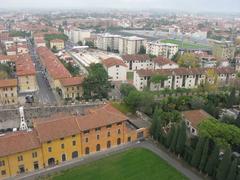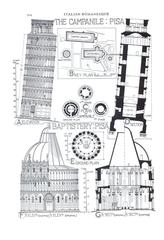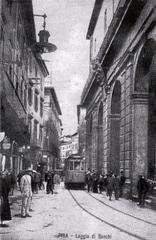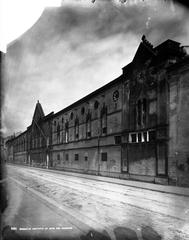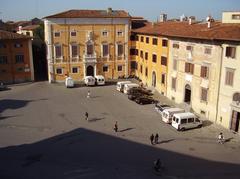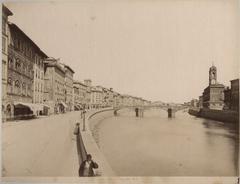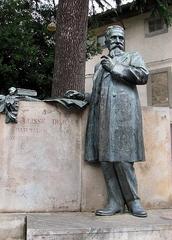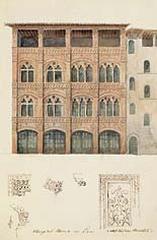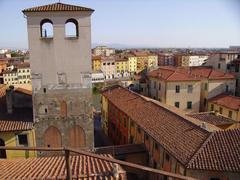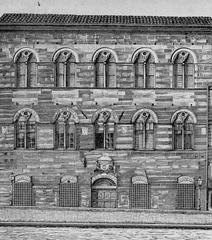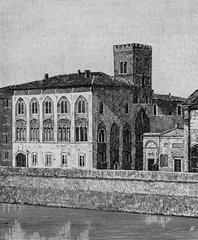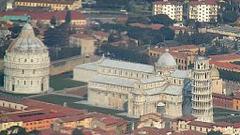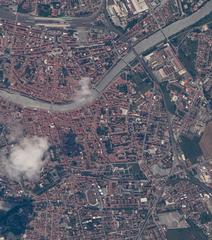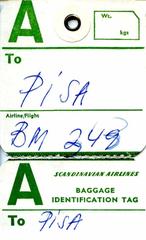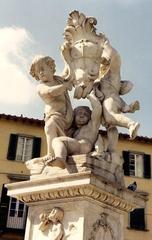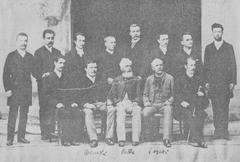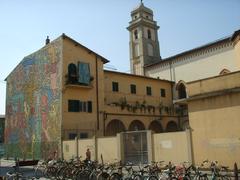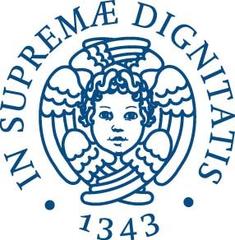Museum of Physics Instruments Pisa: Complete Guide to Visiting Hours, Tickets, and Historical Significance
Date: 14/06/2025
Introduction
Located at the heart of the University of Pisa, the Museum of Physics Instruments (Museo degli Strumenti di Fisica) is one of Italy’s most important repositories of scientific heritage. Home to over 2,000 historic artifacts—spanning optics, mechanics, electromagnetism, acoustics, and astronomy—the museum offers a fascinating window into centuries of scientific innovation. Whether you are a science enthusiast, a history buff, or a traveler eager to explore Pisa’s intellectual legacy, this guide provides everything you need: from the museum’s origins and collection highlights to up-to-date visiting hours, ticket information, accessibility, and nearby attractions.
For further details and ongoing updates, consult the official museum resources (Pisa Tour), (Visit Tuscany), and (University of Pisa).
Historical Background and Significance
Origins and Foundation
The Museum of Physics Instruments was established in 1989 by the Department of Experimental Physics at the University of Pisa. Its core mission is to preserve and study the university’s vast collection of scientific instruments—many dating back to the 17th century and associated with pivotal moments in the history of science (Pisa Tour). The University of Pisa, founded in 1343, has long been a bastion of scientific advancement, counting luminaries such as Galileo Galilei among its alumni. The museum’s foundation represents a commitment to safeguarding this tradition and making it accessible to the public and scholars alike.
Growth and Development of the Collection
The museum’s collection has been enriched through careful preservation of laboratory equipment and strategic acquisitions from other institutions. Today, it houses over 2,000 objects, including such treasures as Galileo Galilei’s compass and the pneumatic machine attributed to Van Musschenbroek, reflecting Pisa’s international role in the scientific community. The collection’s breadth—from early telescopes to 20th-century electronic devices—charts the evolution of scientific inquiry and education.
Scientific and Educational Importance
Beyond its role as a historical archive, the museum is an active educational hub. It supports scholarly research, offers guided tours and educational workshops, and provides hands-on access to original scientific instruments. Its archival resources, such as the Pacinotti Fund and the Fermi-Persico Archive, are invaluable for historians of science and technology (Visit Tuscany).
Pisa’s Scientific and Cultural Context
Pisa’s reputation as a center of scientific excellence is embodied in this museum. The preservation and display of items linked to Galileo and other pioneers highlight the city’s role in the Scientific Revolution and its ongoing commitment to scientific literacy and public engagement.
Notable Artifacts and Their Stories
- Galileo’s Compass: This celebrated instrument, reputedly belonging to Galileo Galilei, illustrates his contributions to navigation and physics and anchors Pisa’s scientific heritage (Pisa Tour).
- Van Musschenbroek’s Pneumatic Machine: A hallmark of early vacuum studies, this device demonstrates Pisa’s connections to the broader European scientific community.
- 17th–20th Century Instruments: The museum’s collection spans centuries, including telescopes, microscopes, early electrical apparatus, and pioneering electronic instruments, each telling stories of discovery and innovation.
Organization of the Collections
Artifacts are thoughtfully organized by discipline, facilitating a chronological and thematic exploration of scientific progress:
- Mechanical Instruments: Includes balances, levers, pulleys, and demonstration models of Newtonian mechanics.
- Astronomical Instruments: Features telescopes, sextants, astrolabes, and celestial globes, including pieces associated with Galileo and 18th-century astronomical research.
- Electromagnetic Devices: Showcases inventions by Antonio Pacinotti—like the first direct-current dynamo—as well as galvanometers and early batteries (Visit Tuscany).
- Chronometric Instruments: Ranges from pendulum clocks and marine chronometers to stopwatches, highlighting advances in scientific timing.
- Optical Instruments: Includes historic microscopes, spectroscopes, and demonstration lenses.
- Acoustic Instruments: Displays tuning forks, resonance tubes, and early phonographs, illustrating the science of sound.
- Scientific Utensils and Miscellaneous Devices: Covers essential laboratory glassware, demonstration kits, and conservation projects.
Each section is supplemented with technical notes, biographies of inventors, and documentation of restoration efforts (Visit Tuscany).
Archival Collections
The museum’s archives are among its most valuable resources:
- Fondo Pacinotti: Documents and artifacts related to Antonio Pacinotti’s work in electromagnetism.
- Fermi-Persico Archive: Materials from Enrico Fermi and Emilio Persico, central to the history of modern physics.
- Riccardo Felici Archive: Focused on studies in electromagnetism.
These collections are housed within the University of Pisa’s library network and support advanced research (Visit Tuscany).
Educational Outreach and Public Engagement
School Programs and Public Tours
The museum offers tailored guided tours and hands-on laboratory activities for school groups and visitors, demystifying complex scientific concepts and bringing history to life (fondazionegalileogalilei.it). Educational activities have continued at the Ludoteca Scientifica and Cittadella Galileiana during the museum’s temporary closure (msf.sma.unipi.it).
Special Events and Community Involvement
Annual events such as the “Galilean Days” celebrate Galileo Galilei’s legacy with solar observations, public lectures, and themed tours (turismo.pisa.it). Collaborations with universities and cultural institutions foster a vibrant community of science enthusiasts.
Contribution to Pisa’s Cultural Identity
- Preservation of Scientific Artifacts: The museum strengthens Pisa’s status as a center for scientific achievement through the conservation of rare instruments and archival materials (visittuscany.com).
- Role in Pisa’s Museum Network: As a member of the University of Pisa’s museum system, it complements collections in natural history, mathematics, and art, and is located near key city landmarks (msf.sma.unipi.it), (fondazionegalileogalilei.it).
Practical Visitor Information
Location
- Address: Museo degli Strumenti di Fisica, University of Pisa, Via Nicola Pisano, Pisa, Italy
- Setting: Central campus, steps away from the Leaning Tower, Cathedral, and River Arno (thecrazytourist.com).
Visiting Hours (as of June 2025)
- Status: The museum is temporarily closed for renovations.
- Usual Schedule: Tuesday–Sunday, 9:00 AM – 6:00 PM. Always confirm current hours on the official website.
Tickets
- Standard Admission: ~€5
- Reductions: For students, seniors, and groups
- Free Entry: For children under 12 and University of Pisa affiliates
- Purchase: Online or on-site (when open)
- Group Bookings: Advance reservation required for school and educational groups (fondazionegalileogalilei.it).
Accessibility
- Wheelchair Access: Provided, with assistance available for visitors with disabilities; check with the museum for any limitations due to the historic building.
- Currently: Educational activities at Ludoteca Scientifica maintain accessibility standards (msf.sma.unipi.it).
Facilities and Amenities
- Restrooms: Available on-site
- Gift Shop: Offers books and science-themed souvenirs
- Dining: Numerous cafés and restaurants nearby
Photography and Conduct
- Photography: Permitted for personal use (no flash/tripods); follow posted restrictions.
- Visitor Conduct: Respectful behavior is expected as the museum is both an exhibition and a research space.
Nearby Attractions
- Pisa Cathedral and Leaning Tower
- Botanical Garden of Pisa
- Domus Galilaeana
- Museum of Calculation Instruments
- Piazza dei Miracoli
Combine your visit to the museum with these landmarks for a comprehensive Pisa experience (turismo.pisa.it).
Multimedia and Virtual Engagement
- Virtual Tour: Explore collections online via the official virtual tour.
- Images: The museum’s website includes high-quality images of key artifacts and interactive digital resources to enhance the visitor experience.
Impact on Science Communication
The museum plays a vital role in promoting scientific literacy by contextualizing its artifacts within broader scientific narratives. Its outreach activities inspire new generations to engage with science, fostering curiosity and critical thinking.
Frequently Asked Questions (FAQ)
Q: What are the Museum of Physics Instruments Pisa visiting hours?
A: As of June 2025, the museum is closed for renovations. Normally, it is open Tuesday to Sunday, 9:00 AM–6:00 PM. Always check the official website for updates.
Q: How can I buy tickets?
A: Tickets are available online or on-site when the museum is open, with discounts for students, seniors, and groups.
Q: Is the museum wheelchair accessible?
A: Yes, with accessible routes and facilities. Contact the museum for specific needs.
Q: Are guided tours available?
A: Yes, for groups and general visitors by advance booking. Tours are typically available in Italian and English.
Q: What are nearby attractions?
A: The Leaning Tower, Pisa Cathedral, Botanical Garden, and Domus Galilaeana are all close by.
Summary and Recommendations
The Museum of Physics Instruments Pisa embodies the city’s enduring legacy of scientific innovation. Its extensive collections, notable artifacts from Galileo and Pacinotti, and commitment to educational outreach make it an essential destination for anyone interested in the history of science. Although the museum is temporarily closed for renovations, its mission continues through digital initiatives and off-site educational programs, ensuring ongoing public engagement.
For the latest updates on reopening, virtual resources, and educational offerings, visit the official museum site. Enrich your Pisa itinerary by exploring the broader network of historical and scientific attractions, and consider using the Audiala app for enhanced guided experiences.
Sources and Further Reading
- Pisa Tour
- Visit Tuscany
- Museum of Physics Instruments at University of Pisa
- The Pacinotti Fund: A Heritage of Science and Innovation
- Fondazione Galileo Galilei
- Pisa Tourism Official: Pisa is Galileo and the Science
- Sistema Museale di Ateneo, University of Pisa
